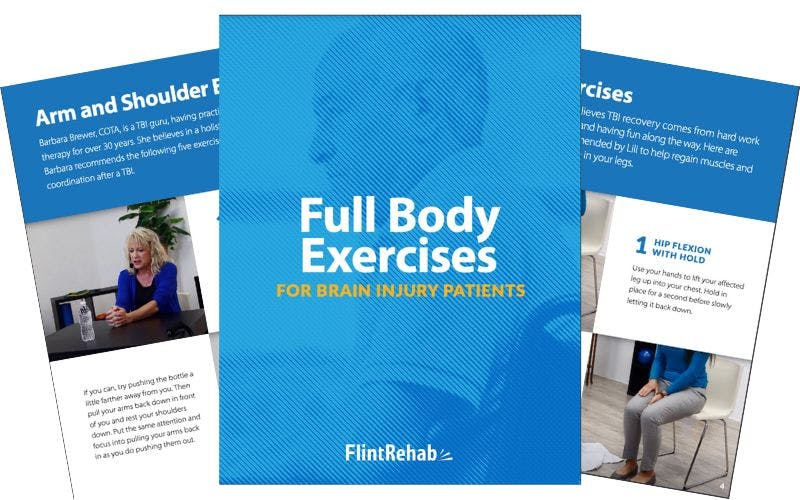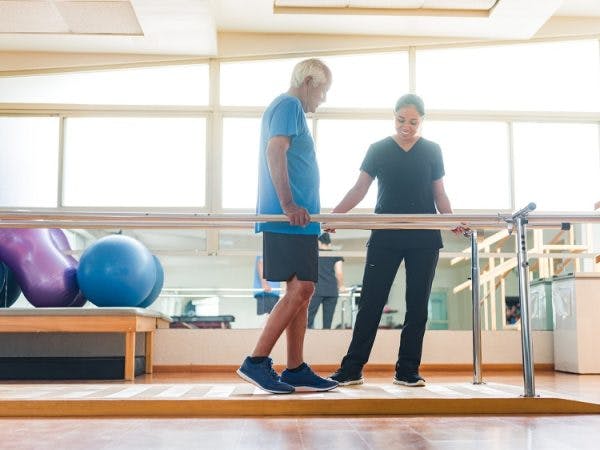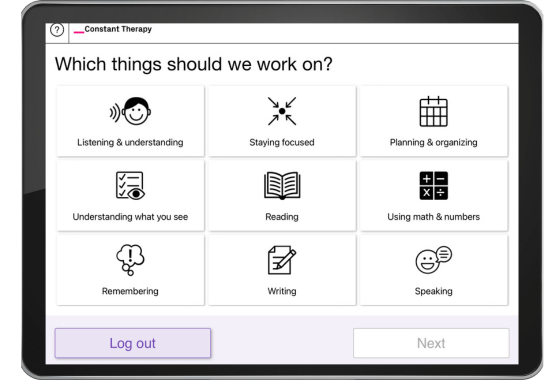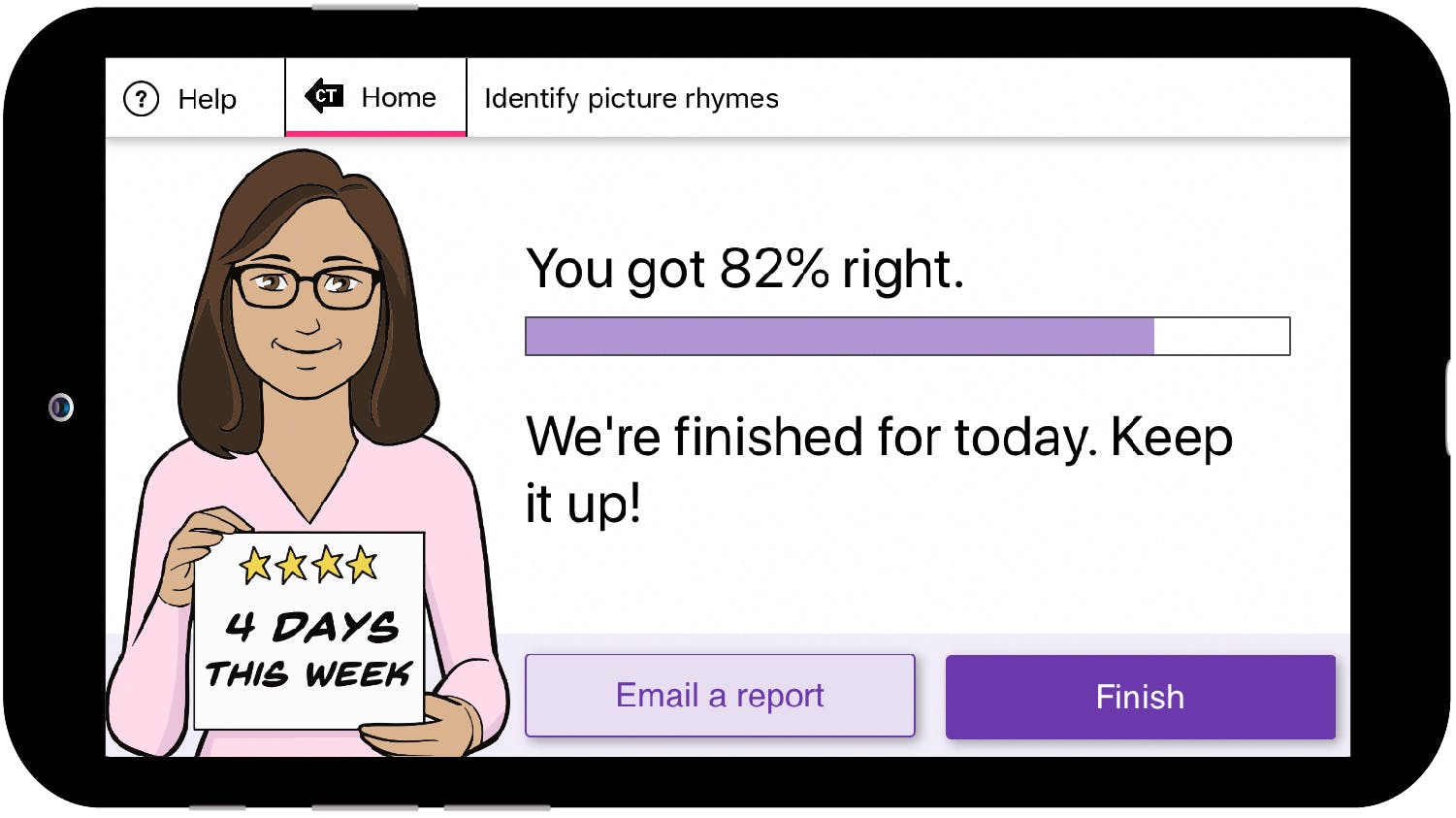Dysphagia is a common physical effect of brain injury that makes it difficult for patients to swallow on their own. It often affects people in early stages of severe brain injury recovery.
To help you manage dysphagia after TBI, this post will discuss the causes and treatment methods.
It’s important to work with a qualified speech therapist to diagnose and treat dysphagia after brain injury. To provide an idea of how your speech therapist may treat dysphagia, this post will also share some exercises that help improve your swallowing skills.
Use the links below to jump straight to any section:
- What Causes Dysphagia After Head Injury?
- Signs of Dysphagia After Head Injury
- Diagnosing Dysphagia
- Treatment for Dysphagia After Head Injury
- Exercises for Rehabilitating Swallowing Skills
- What Foods Can You Eat if You Have Dysphagia?
- How Long Does Dysphagia Usually Last?
What Causes Dysphagia After Head Injury?

Before we can discuss treatment for dysphagia after a head injury, we will explain how swallowing works. Although swallowing may look like a simple action, it actually involves 26 different muscles in the mouth, neck, and throat.
All 26 muscles must coordinate with each other to get food and liquid from your mouth down to your stomach. To accomplish this, your brain sends signals to each muscle, telling them precisely what to do and when to do it.
The swallowing process consists of four stages:
- Oral preparatory stage. In the first stage, your brain prepares your mouth for food by triggering saliva production, which will make chewing and swallowing easier.
- Oral stage. This is the chewing stage, but chewing requires more than just your teeth! Your tongue, cheeks, and lips all work together to mash food into a small, round mass, which the tongue moves to the back of the throat to prepare for the third step.
- Pharyngeal stage. When the food reaches the back of the throat, the pharynx muscles contract to push the food down into the esophagus. Other muscles also contract to close off the trachea and prevent choking.
- Esophageal stage. Finally, the muscles in the esophagus push the food into the stomach.
Depending on where the brain damage occurred, you may have problems with any one or more of these stages.
For example, your brain may no longer signal your mouth to produce saliva, which will make food stick in your mouth and throat. Or your brain injury could weaken your tongue and lip muscles, which will not only make swallowing impossible but also cause slurred speech.
This is an example of how every brain injury is different, and therefore symptoms manifest differently in every patient.
Signs of Dysphagia After Head Injury

Many people with dysphagia do not realize that they have problems swallowing. This can lead to serious health hazards. The following are a few signs that your loved one might have dysphagia after their head injury:
- Coughs after swallowing
- Uncoordinated chewing
- Drool
- Weak voice
- Grimaces while swallowing
- Eats slowly
- Complains about pain behind the sternum when eating
- Pockets food in cheeks or gums
- Wet, gurgling cough
Severe dysphagia can lead to aspiration. Aspiration is usually accompanied by fits of coughing and wheezing, as the body tries to force the foreign objects out of the lungs. If the person can cough hard enough, they may be able to clear out their lungs before pneumonia develops.
However, often severe head injury patients do not have this cough reflex. As a result, they may aspirate food and water without even feeling it. Doctors call this phenomenon silent aspiration, and it can be extremely dangerous.
Since silent aspiration may cause serious cases of pneumonia, caregivers should familiarize themselves with the symptoms of dysphagia and take steps to prevent choking.
Diagnosing Dysphagia
There are also several swallowing tests that doctors use to confirm a diagnosis of dysphagia. These include:
- Barium Swallow Test. The patient swallows a fluid with barium (a dye that shows up on X-ray) to determine how the muscles function.
- Dynamic Swallow Study. The patient chews and swallows food coated with barium while under an X-ray. This allows doctors to see how well you can chew.
- Fiber-Optic Swallow Evaluation. With this test, doctors put a small tube with a camera down the throat to observe how well the esophageal muscles move.
- Hydration assessment. This is done initially to make sure the patient is getting enough water. If they aren’t, it may be a sign they have trouble swallowing fluid.
- Manometry. Very similar to the fiber-optic test, except this test measures muscle pressure when swallowing. It’s an effective way to tell if weak muscles are causing you to choke.
Once your doctor makes a diagnosis, you can move forward with treatment.
Treatment for Dysphagia After Head Injury

There are several effective ways to treat dysphagia after a head injury.
The most severe dysphagia patients may require the use of a feeding tube that delivers food directly to the stomach to prevent choking and malnourishment.
Normally, severe TBI patients that require a feeding tube can receive ongoing care at a skilled nursing facility.
If you don’t require a feeding tube, then your speech therapist may teach you compensation techniques to eat safely along with exercises to improve your swallowing skills.
Exercises are important for recovering from dysphagia after a brain injury because it helps stimulate the brain and activate neuroplasticity. Consistent, regular exercise helps improve your swallowing skills — the same way that consistently practicing anything improves a skill.
The brain responds to repetitive practice. Next, we’ll discuss a variety of therapeutic exercises that your speech therapist may recommend for dysphagia recovery.
Exercises for Rehabilitating Swallowing Skills
Your Speech-Language Pathologist is the best person to ask for recommended exercises. They understand how to choose the most effective exercises for your ability level.
Below, you will find some common swallowing exercises that may help with dysphagia. Please consult with a speech therapist before you begin exercising.
1. Straw and Paper
- Cut up paper into 5 small pieces and place the pieces on a table.
- Place a cup on the table.
- Put a straw in your mouth. While holding the straw above a piece of paper, suck through it. The paper should stick to the bottom of the straw.
- Keep sucking on the straw and move the paper into the cup.
- Repeat until all the pieces of paper are in the cup.
This exercise strengthens your cheeks and tongue, which may improve swallowing skills.
2. Dry Swallow
- With your mouth empty, try to swallow your saliva.
- Squeeze you swallowing muscles as tightly as you can.
- Cough at the end.
You can also try holding your breath as you swallow. This uses more muscles, which may improve the strength in your throat and tongue.
3. Tongue Exercises
- Stick out your tongue. Place a spoon against your tongue, then push your tongue against it for 10 seconds. Repeat 5 times.
- Place your tongue behind your teeth. Curl your tongue towards the back of your mouth. Hold for 10 seconds. Repeat 5 times.
4. Effortful Swallow
- Swallow as hard as you can. While doing so, push your tongue up to the roof of your mouth.
If you do these activities frequently, you may rewire your brain to recover muscle strength and coordination in your mouth.
What Foods Can You Eat if You Have Dysphagia?

During TBI recovery, your speech therapist may recommend compensation techniques to eat and drink safely.
Your speech therapist may also create a personalized diet that fits your needs, and some foods they might suggest include:
- Pureed foods. Patients who have minimal chewing abilities require purée for meals. Pudding and yogurt would also work.
- Soft foods. These require more chewing but are still easy to swallow. Examples: cottage cheese, mashed potatoes, and scrambled eggs.
- Soft-solid foods. These are foods that need even more chewing but are easily cut and mashed, such as tender meats, fruits, and vegetables.
In addition, avoid crunchy or sticky foods such as nuts and crackers until your speech therapist approves.
How Long Does Dysphagia Usually Last?
For most brain injury patients, dysphagia may improve after several months of rehabilitation.
There are several signs that doctors look for that may indicate that swallowing will return soon, including:
- The person is alert and understands what is happening.
- They have trouble controlling their mouth muscles, but not their throat muscles.
- They are able to take deep breaths.
- If food gets stuck, they are able to cough it up.
If these signs are not present, the person may still overcome their dysphagia, but it will take more time and effort.
Living with Dysphagia After Head Injury
Swallowing is a complex process that involves multiple areas of the brain and over two dozen muscles. Damage to any of these can lead to dysphagia.
Since dysphagia is so dangerous, it’s crucial to find a speech therapist who will teach you exercises that improve your swallowing skills.
As you practice those swallowing exercises, your brain relearns how to control your mouth muscles again, and your dysphagia may improve.














